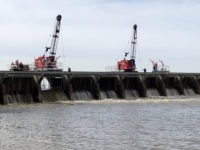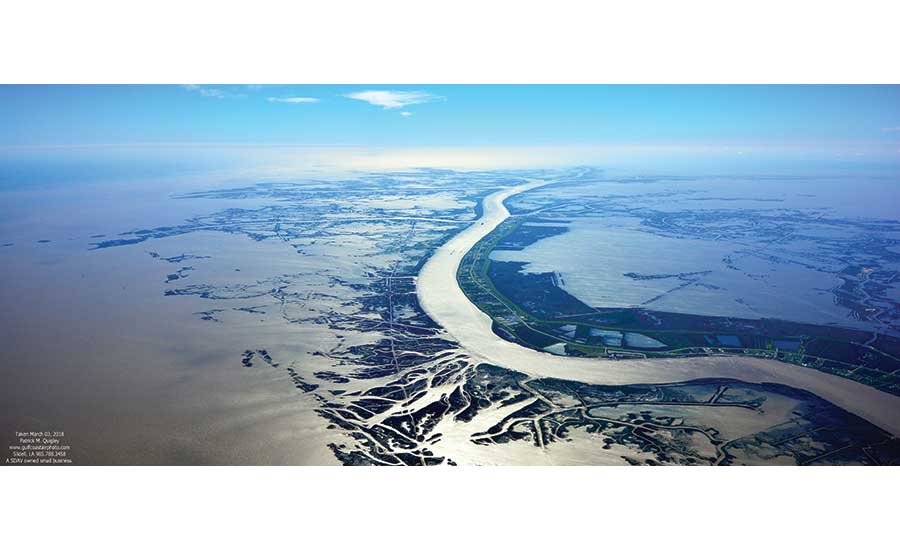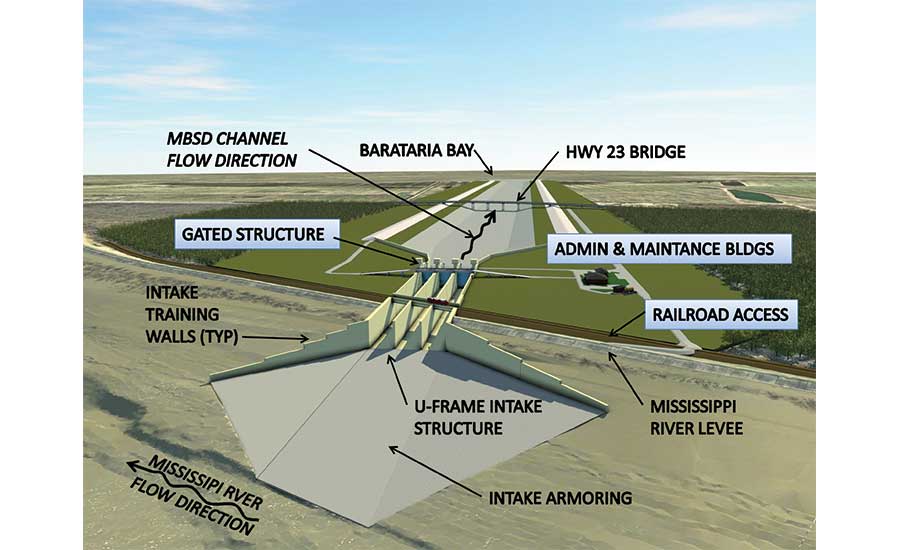Mississippi River Diversions Could Save Louisiana's Drowning Coast
Engineering underway for linchpins of state's $50 billion master plan

An aerial view looking from Venice, La., toward the end of the Mississippi River in the Gulf of Mexico. Without regular silt deposits from the river, the land on the right, which was once a cypress swamp, is now largely open water. The diversion projects, upstream from Venice, will reconnect the river to some wetlands.
PHOTO COURTESY OF PATRICK QUIGLEY / GULF COAST AIR PHOTO

AECOM has prepared a preliminary illustration of the components of the Mid-Barataria diversion and an animation showing one way it could be built.
MAP COURTESY CPRA

The animation shows: coffer dams built to reinforce the levee
ANIMATION COURTESY AECOM.

The animation shows: sheet pile system installed and intake structure built in the dry
ANIMATION COURTESY AECOM.

The animation shows: the site flooded and the intake structure floated in place in the river;
ANIMATION COURTESY AECOM.

The animation shows: the final structure.
ANIMATION COURTESY AECOM.

Eroding wetlands southeast of Belle Chasse, La. A marsh restoration project on Lake Lery is shown at the bottom.
PHOTO COURTESY OF PATRICK QUIGLEY / GULF COAST AIR PHOTO

Louisiana engineers have become experts in building land with dredged mud and sand. Whiskey Island, a barrier island, is still under construction.
PHOTO COURTESY OF CPRA

A pipeline places dredged material from the gulf and the river to recreate the Caminada Headlands, another barrier island.
PHOTO COURTESY OF CPRA

A state agency has determined that an oil port, proposed just north of the Mid-Barataria Diversion, is not inconsistent with plans for the diversions, intended to shore up wetlands south of New Orleans.
PHOTO COURTESY OF CPRA










Engineers are working to help reconnect the Mississippi River to Louisiana’s sediment-starved wetlands in an effort to rebuild some of the land that is disappearing at a rate of almost 11,000 acres a year—or roughly a football field an hour.
The reconnection, which will divert a portion of the Mississippi River, has been discussed for more than 30 years. Two such diversions are finally under design, to be funded by fines from the 2010 Deepwater Horizon explosion and oil spill. The first of these projects, the $1.4-billion Mid-Barataria diversion, has a construction manager-at-risk on board and should be under construction within five years. The second, the $800-million Mid-Breton diversion, is expected to start a few years later.
The diversions will be major civil works projects without compare. The work will require careful scheduling to maintain flood protection as the Mississippi River levee comes down and a diversion gate is put in its place. And that will be the easy part. The projects must be operated to divert the most river sediment and the least amount of water to minimize the impact on the people and wildlife in Barataria Bay. Too much river water could flood communities and kill fisheries.
“This is not rocket science—it’s a lot harder because it’s so complex,” says Don Boesch, professor of marine science at the University of Maryland and former executive director of the Louisiana Universities Marine Consortium at Louisiana State University.
The $2.2-billion diversions are the linchpin of Louisiana’s $50-billion coastal master plan, which aims to create 800 sq miles of land over the next 50 years to help sustain 40% of the wetlands in the continental United States and support, among other things, 500 million tons of cargo shipping and $44 billion in oil and gas production along Louisiana’s coast.
“If we don’t figure it out, it could become an economically crippling issue for the U.S. in the long term,” says Jacobs’ Josh Crowe about Louisiana’s coastal problem. Crowe is coordinating efforts on the two diversion projects for Jacobs.
The work being done in Louisiana, however, already has had a worldwide impact.
Louisiana’s integrated restoration and flood protection approach, as well as the sheer number of coastal restoration projects in the state, make it a living laboratory that has attracted attention from as far away as India, Indonesia and the Netherlands. A lineup of major engineering companies is working on various aspects of the master plan, including Jacobs, TetraTech, Arcadis, AECOM and Stantec.
A 2014 study by The Data Center, a nonprofit research aggregator in New Orleans, found almost 65,000 people were employed in the state’s water management industry, including more than 3,000 engineers and 13,000 people working in construction.
Louisiana’s Coastal Story
“Our company uses the Louisiana experience in anything they do if it’s coastal. That’s true for every company I’ve worked for,” says Steve Mathies, who is leading the Stantec team chosen to design the Mid-Breton diversion. Previously he has worked for AECOM and CH2M and served as executive director of the state’s Coastal Protection Restoration Authority (CPRA). “We continue to have a great story to tell here,” he says.
That story began when the levees were built along the lower Mississippi in the 1800s, and it hit a major turning point in 1928, when the Mississippi River levee system was authorized. The levee system starved the land of the river silt that helped build and sustain it. Between 1932 and 2010, Louisiana lost about 1,800 sq miles of land. But the climax came during hurricanes Katrina and Rita in 2005, when Louisiana lost more than 150 sq miles to the storms and the state realized just how vulnerable it is to storm surge and flooding.
“Katrina and Rita really jump-started the field” of flood risk and resiliency, says Brett McMann of Arcadis, which works with the state on its master plan. The state created the Coastal Protection and Restoration Authority in 2005 to coordinate efforts on coastal restoration. The CPRA issued its first master plan in 2007, which, by law, it updates every five years. Last year, the state legislature approved the third plan with just a single dissenting vote.
Science is the foundation for that unprecedented level of support. Projects submitted to the plan are analyzed, modeled and then chosen in part on the basis of how much land they can build and how they will complement other projects in the master plan.
The current master plan specifies 124 projects, some of which will build about 800 sq miles of land. Of the $50 billion, $5 billion will go to diversion projects, including the two in-design “mid-basin” diversions; $6 billion will be spent on nonstructural risk reductions such as flood proofing, elevations and buyouts; and another $19 billion is set to go to structural protection such as levees and barriers.
Marsh and barrier island creation through dredging will receive almost $18 billion. Dredging has been the state’s primary land-building tool. Since about 2007, CPRA staff has designed and constructed 20 marsh creation projects by dredging, totaling nearly 10,000 acres of wetlands, says Rudy Simoneaux, engineer manager at CPRA.
Later this year, the CPRA will finish rebuilding Whiskey Island, a 5-mile-long uninhabited island that includes a beach, dunes and back marsh, using 15.8 million cu yd of offshore sand. The process of creating wetlands and islands has been a learning process for the CPRA staff, Simoneaux says. Rates of subsidence, ecology and uses for the land are different for every project. “The coast is something we are writing the book on,” Simoneaux says. “There’s no standard that you pull off the shelf. You innovate on every project you work on.” Even the most perfectly executed marsh creation project has a major inherent flaw. Without regular renourishment of sand or sediment, it will eventually subside or be covered by rising seas.
Enter the river diversion projects.
River sediment diversions were first proposed in the 1970s. The U.S. Army Corps of Engineers published its first feasibility study for a diversion below New Orleans in 1984. “Nothing tells me you can do this without river reintroduction in the toolbox, since that is the tool that built the place,” says Mark Davis, director of Tulane University’s Institute on Water Resources Law and Policy.
Acceleration
Through CPRA and its master plan, the effort to build diversions has accelerated. The state, supported by a cadre of scientists, methodically examined different sites and finally settled on a spot for its first diversion, the Mid-Barataria project, which will move up to 75,000 cu ft per second of water, at river mile 60.7, about 30 miles below New Orleans.
In 2014, HDR Engineering completed a preliminary basis of design for the project that has helped price the diversion at $1.4 billion, including a 19% contingency and a 27% escalation. In 2017, the state selected AECOM to engineer the project. The company is working with 14 subcontractors. AECOM anticipates reaching the 15% design mark later this year.
In February, the state selected Stantec to design the Mid-Breton diversion, to be nine miles upriver on the opposite bank from the Mid-Barataria diversion. It will move up to 35,000 cu ft per second of water. Mathies says Stantec will reach 30% design within 18 months and CPRA will begin the search for a Mid-Breton CMAR in the first quarter of 2019.
While AECOM has a long way to go before the Mid-Barataria design is finished, some elements are known. The structure is to accommodate a flow of 30,000 to 75,000 cu ft per second when the river reaches a flow of 450,000 cu ft per second or greater, when it will carry the greatest land-building sediment load. Modeling shows the diversion could deliver between 2 to 3 million cu yd of sediment a year.
“We are trying to reestablish connections between the river and basin using natural processes as much as possible. We are trying to minimize things that are highly engineered,” says Ehab Meselhe, a wetland hydrologist and engineer at the Water Institute of the Gulf. Meselhe has helped guide the projects with his hydraulic modeling. “We are de-engineering things. That is the spirt and the goal of the master plan,” he says.
During construction, about 1,000 ft of the Missis–sippi River levee system will be taken down to build an intake structure and gates on the river. The project will also have a two-mile conveyance channel, a back structure and an outfall area. It will also require the relocation of a highway, a railroad and utilities.
AECOM must still refine a host of variables, including whether the segments will be cast in place, whether they will be completed in wet or dry conditions, and how the final intake and structures will be configured.
In June, CPRA selected the Archer Western-Alberici joint venture as construction manager-at-risk for the project so it can provide constructability guidance. The state is finalizing its $13.8-million preconstruction contract with the company.
“[The team has] folks with so much expertise in Louisiana’s coast, they are not going to see something that they have never seen before,” says Jimmy Rayburn, coastal restoration manager for AECOM. For example, the hurricane protection system built around New Orleans had several components similar to the diversions, including the massive West Closure Complex (ENR 12/10/12). The Mid-Barataria diversion will be even larger and more complex, and it will be the first controlled sediment diversion project ever built.
Still, building the diversions along the Mississippi River levee during spring flooding season could get tricky. The Corps can halt construction activity near the levee when the river nears flood stage. AECOM and CPRA hope that Archer Western-Alberici will add a level of construction experience to prepare for those contingencies.
“The complication is making sure that we design and sequence in a safe manner to maintain a level of protection,” says Brad Barth, manager of the diversion projects for CPRA. “Maybe we add redundant features to boost our confidence, maybe we alter the elevation of the cofferdam,” Barth says. He adds there still could be times when “we might not be able to work on the river” to assure safety and flood protection.
As AECOM and its 14 subcontractors continue to refine the design, the federal environmental impact statement (EIS) process is underway, led by the Corps. Third-party contractor Gulf Engineers and Consultants is preparing the EIS. Under a memorandum of understanding with the White House, the Corps will work to issue a decision on the project by 2020—two years earlier than it had previously scheduled.
Rayburn says AECOM is building flexibility into the design of the diversion project so it can be modified if the EIS calls for changes to the structure.
When completed, the diversion will be managed adaptively to maximize the sediment load and minimize its impacts. “Adaptive management is finding the right balance,” says Natalie Peyronnin, director of science policy for the Mississippi River Restoration for the Environmental Defense Fund. Peyronnin is spearheading a group of scientists and interested parties who are helping develop operational guidance. “There will be a gradual opening of the diversion over many years in which we can learn and adjust operations.”
Modeling shows the river water will at first cut a channel in Barataria Bay, but, within five years, the diversion will begin to build land, according to Meselhe.
In conjunction with the diversion, CPRA plans to use dredged material to build marshes in Barataria Bay to help capture river sediment at crucial locations. “It all works together,” says Clint Willson, a civil and environmental engineering professor at Louisiana State University. Willson oversees a 90-ft by 120-ft physical model of the lower Mississippi River that will help validate the computer modeling of the diversions. Additionally, Alden Labs in Massachusetts is building a larger-scale model of the Mid-Barataria diversion.
The physical and computer models will run a range of scenarios to help get a better handle on the greatest unknown of the diversion projects—the rates of sea-level rise and subsidence. “We really don’t know what our hydrograph is going to look like in 2030 or 2032. Our job is to look at a couple of different extremes and plan for that,” says Barth.
Current modeling shows sea level rise could range from 0.5 meters to 2 m by the year 2100, while subsidence varies by location up to 35 millimeters per year.
Proponents fear that if the project doesn’t get built quickly enough, there won’t be any land to build upon. “The solutions we are entertaining today are not going to be possible down the road; there is a closing window,” Meselhe says. “If that window closes, if that basin becomes too deep, marsh creation will not be possible. Diversions will not be possible.”
The fact that there is opposition is natural and expected, says Davis. “You are going to affect people; you are going to affect uses. You have to decide if saving the culture and economy is worth those impacts.”
Plaquemines Parish residents who oppose the diversions say the freshwater will destroy oyster beds and affect shrimping and fishing. The state acknowledges there will be changes, but says without the projects, there may be no fisheries at all.
There is also scientific opposition to the project. Gene Turner, a Louisiana State University geologist and ecologist, says there’s only so much river sediment to go around. If the sediment is used in one location, another will starve. “It is a zero-sum game,” says Turner, who believes a better option would be to backfill miles of canals dug by oil and gas companies that accelerated wetland erosion.
CPRA says its modeling accounts for the available sediment and that the outcome of the EIS will require it to change design or modify operations if the diversion will cause too much harm. Davis says backfilling the canals might be a good tool to combat wetland loss, but because of land rights, it’s not an option.
Design, construction, management, politics and funding aside, the state’s overall efforts are still facing stiff odds. “There’s not a single scenario that we have that reclaims the historic footprint,” says Stantec’s Mathies. “We’re trying to hold the line in the sand.”
CPRA’s own modeling shows that, unless the master-plan measures are taken, the state could lose between 1,207 and 4,123 sq miles in that time frame. And the state has secured only $20 billion of the $50 billion called for in the master plan to fight that loss. The next stab at the master plan will examine different approaches to building land, says Bren Haase, chief of planning for CPRA. “When you look at the future it’s not acceptable. We still lose an awful lot of land.”
Just One Chance
“We really only have one chance,” says John M. Barry, author of “Rising Tide,” a book about the 1927 Mississippi River floods. Barry was a member of the levee board responsible for New Orleans-area flood protection until he led a levee board lawsuit against oil companies for the damage they caused to Louisiana’s coast. The lawsuit was rejected by the U.S. Supreme Court. Since then, however, 20 coastal parishes have filed similar lawsuits against the oil companies. If the parishes, which should have greater legal standing than the levee board, win, the oil companies could be forced to help fund coastal restoration, Barry says. But that still may not be enough. “Even if you get the funding right and even if you solve the political problems, the ultimate decider is going to be nature,” he says.
The fate of Louisiana’s coast notwithstanding, the efforts to save the wetlands are having a ripple effect worldwide. “Louisiana has been an exemplar of integrated science. It’s brought together engineers, social scientists, coastal geologists,” says Jordan Fischbach, a senior policy researcher at the RAND Corporation focusing on water and resilience issues. Fischbach and RAND have been involved in the state since Hurricane Katrina, when the firm came to a “fundamental realization that the entire state was at stake,” Fischbach says. RAND recently used the Louisiana model in a study of solutions to reduce tidal flooding and improve water quality in New York City’s Jamaica Bay. It also is examining how Louisiana’s approach can be applied to environmental restoration in the Chesapeake Bay.
Louisiana’s efforts also could also impact the engineering profession. Working on the coast requires engineers to consider not only the costs and integrity of a structure, but also how that structure will impact the ecosystem in which it exists, says Meselhe. “How is that structure going to affect alligator eggs?” he asks rhetorically. “That is not fluff. That is the kind of thing we need to be considering. Your solution needs to be broader.”
The combination of ecology, geology and engineering is attracting students to Louisiana State University and the University of New Orleans. Both have expanded their focus on integrated coastal engineering.
“What we are dealing with now is going to inform other communities with similar delta situations,” says Norma Jean Mattei, interim engineering dean at UNO and a civilian member of the Mississippi River Commission. “Again, we are a living lab.”
Working on Louisiana’s coast also gives engineers a chance to be involved in something that’s “really really important.” says AECOM’s Rayburn. “I think people naturally want to be a part of something like that.” And because Louisiana is harnessing that passion and enthusiasm, it may well provide a worldwide example of how a coastal community can hold off the rising seas.
“You don’t know everything that you are dealing with,” Tulane’s Davis points out, “but you do know that there are things that we can do that will give us a better chance.”













